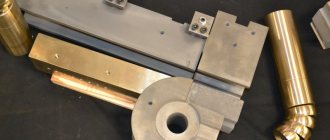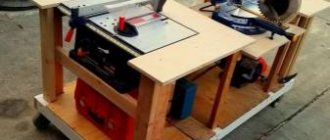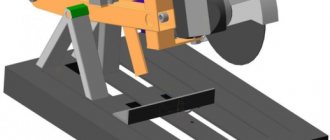It’s not that difficult to make a homemade or even a professional pipe bender with your own hands in order to be able to bend pipes at a given angle and, importantly, with a given bending radius.
Making a pipe bender with your own hands is not so difficult
Contrary to popular belief that this device is most often used when performing plumbing work, in such cases various fittings and elbows are usually used - pre-bent sections of pipes manufactured in industrial conditions. However, there are restrictions on the use of bends, which are determined by their standard characteristics:
- rotation angles (can be 45, 60, 90 and 180 degrees);
- bending radii (bends with bending radii of 1.0 DN and 1.5 DN are available);
- use of welding.
Not in all situations such parameters can satisfy those who need to give a pipe structure the required shape. It is in such cases that a mechanical pipe bender (or manual pipe bender) comes to the rescue.
Those owners of dachas and private houses who are going to independently produce various arched structures, greenhouses, custom-shaped fences and much more cannot do without a machine for bending steel pipes.
In this article we will thoroughly examine how to make a pipe bender with your own hands. After all, a homemade pipe bender can be used not only at home, but also in semi-professional activities, since its design is not sky-high in complexity, and commercial devices for bending pipes are quite expensive. Therefore, by making a manual pipe bender with your own hands, you will save a lot of money.
Two pipe benders: manual and electric
How to build a hydraulic pipe bender
The design of a hydraulic pipe bender with your own hands is presented in the video below.
Building a tool of this type will not be difficult if you have two 0.5 meter channels at your disposal. The base of such a device included the following elements:
- hydraulic cylinder;
- stops;
- supercharger.
In addition, you should also highlight:
- A jack that can withstand loads of up to 5 tons.
- There are 2-3 rollers.
- Channel - 3-4 mm.
- Thick plates.
The principle of using such a tool is that you need to install a profiled pipe into the shoe. Use a jack to set the required bending radius. When the jack is inflated, the rod rises, pressing on the roller. After establishing the bending angle, the pipe can be removed. This type of bending device is relevant when it is necessary to bend a pipe in one place, for example, when installing a heating system.
Design
Creating a durable and practical profile bending design requires the use of a metal product. The main condition is the rigidity of the base to withstand heavy loads.
Note!
DIY vices: simple and reliable homemade vices from A to Z (190 photos)Do-it-yourself vibrating table - selection of materials, components and assemblies for a vibrating table with a step-by-step manufacturing description
Do-it-yourself grain crusher - operating principle, types and features of creating a device for processing grain crops
A channel is suitable for this. It has the required strength and a large surface area for mounting the necessary elements.
Design and principle of operation of an electric pipe bender
The main load when operating a pipe bender with an electric drive falls on the powerful engine. It is he who transfers the rotational load to the bending element. Various attachments are put on the rotor, the shape of which depends on the expected result.
In addition, the structure of the pipe bender includes the following parts:
- frame;
- clamping devices;
- fastenings;
- control panel.
If it's a cheaper option for regular users, it will usually have setup buttons and a control panel. On industrial machines of this type, displays are installed, with the help of which settings are made.
The main functions of the clamps are:
- reliable fixation of the workpiece;
- protecting the employee from possible injuries.
Fasteners also serve to hold the bent element in the position required for operation.
Electric profile benders
Electrically driven machines have become quite widespread. By supplying energy to the electric motor, a torque is created, which is transmitted through the drive to the working element. Electric profile bending is characterized as follows:
- The equipment is more compact and highly efficient. Compared to a hydraulic drive, an electric drive takes up less space.
- A modern electrically driven profile bender allows bending work to be carried out with high precision. At the same time, the workpiece has high strength.
- The electric drive allows you to automate the production process. There are semi-automatic versions available for sale.
The electric roll forming unit is installed in small workshops, as well as in everyday life. Unlike the hydraulic version, this one is designed to create less pressure. In addition, the device often does not have overload protection.
How to make a pipe bender with your own hands instructions
If you have an example or diagram of a pipe bender, then making the machine yourself will not be difficult. You must adhere to the appropriate sequence of actions. To make a pipe bender for a profile pipe, the following manipulations are performed:
- On the shaft you need to place gears, as well as bearings and rings. The production of shafts is entrusted to an experienced turner. If you plan to create all the parts yourself, then you will need three shafts, two of which are distributed on the lower base (a channel serves), and the third is suspended on springs.
- The corresponding holes are drilled in the rings, which are needed in order to cut the thread. This thread is needed to attach gears to the shafts.
- The shelf for securing the third roller is also made from a channel.
- All elements are distributed on the frame and combined by welding or bolted connections.
- The first step is to install the frame on which the corresponding structural elements are distributed.
- The shelf is welded perpendicularly to the base.
- A handle is attached to one of the shafts.
- Finally, to adjust the bending radius of the profile pipes, you need to install a hydraulic jack on the top shelf.
If you make a tool according to a template, then there will be no difficulties
To clarify some points, you should pay attention to the following factors:
- The pressure shaft located on the shelf must be additionally secured to it. It is also secured with dowels.
- The pressure roller is made by performing the following manipulations: a shaft is fixed to the shelf, as well as springs that are attached to pre-installed nuts. After making the shelf, it can be welded to the frame of the main device.
- To tension the chain, you need to use a magnetic corner. It will serve as a holder.
- The sprockets are fixed with dowels made from Grover.
- The drive handle is constructed from a steel tube.
- The jack is placed on a hanging shelf.
The design of the simplest homemade unit for bending profiled pipes is presented in the video below.
Pressing
To create a machine based on pressing, you will need to install a matrix and a punch.
Note!
Do-it-yourself compressor: selection of materials and tools for assembly at home + step-by-step instructions for making and assembling yourselfHomemade products for the garage with your own hands: options for products for arranging a garage, detailed diagrams and drawings for creating with your own hands
Do-it-yourself press - design features, choice of manufacturing materials. Step-by-step instructions for making it yourself + simple diagrams and drawings
Making a simple template-type pipe bender
A simple rolling pipe bending machine can even be made from wood. Naturally, this will be a manual pipe bender, the design of which may not even include a pressure roller if it is used for thin-walled products. The template for such a device is made from a wooden board, the thickness of which should be such that it exceeds the diameter of the pipe itself.
Wooden template for a simple manual pipe bender
For ease of work, it makes sense to consider profiling the template from its end in order to avoid the pipe jumping off during bending. For these purposes, you can fold two boards, first sawing one edge at a time, thus creating a kind of gutter. A pre-drawn drawing will help avoid mistakes.
When using such a pipe bender, the template is attached to a reliable base, and a stop is attached to the left side of it (for right-handers). The pipe that needs to be bent to the required radius is placed between the template and the stop and carefully bent, making sure that it does not jump off the template.
Collapsible hook template
With the help of such a pipe bender, made from scrap materials, you can bend along a large bend radius. You can avoid making a wooden template and simplify the device by replacing it with metal hooks fixed to the base, located in a circle with the required bend radius. This device is convenient in that the dimensions of the bend can be changed at any time by placing the stop hooks around a circle with a different radius.
Armed with a manual winch, you can significantly expand the range of work performed due to a noticeable increase in traction force for bending pipes.
The winch will help expand the functionality of the simplest manual pipe bender
Useful tips for “pioneers”
For those who are encountering flexible profiles for the first time, it is recommended to take into account some features of the processing technology of this type of pipe. For example, experienced craftsmen never sacrifice the quality of the bend to save time.
It is wiser to do a few gentle presses with the adjusting screw and a few passes on the rollers rather than doing everything at once. This approach completely eliminates deformation of the profile pipe and significantly reduces the load on the drives (or on the master’s muscles).
A made template for the required bend radius of the pipe. Similar templates are also made for profile pipes
It is recommended to work with rollers of a configuration that matches the pipe profile. So, if there is a correspondence between the size of the roller width and the cross-sectional size of the profile, the bend will be accurate and neat. In addition, the master will not have to periodically correct the pipe, which moves from the center of the support roller to its outer boundary.
Before starting the bending operation of a profile pipe, it is advisable to make a template according to a given bend radius. If it is impossible to make a template for some reason, you can limit yourself to calculating the distance obtained between two control points after bending the pipe. Knowing the calculated figures, the workpiece can be bent with a pipe bender without periodic control measurements, thus reducing work time.
How to make different types of pipe benders
The principle of operation of pipe benders is different - you can influence a section of pipe in different ways. For example, a spring-type device will help deform polymer pipes due to pressure. Segmental devices will stretch them, giving them curvature.
The method of making a template pipe bender is accessible even to a beginner. To do this, you need to accurately draw a part of a circle of the required diameter (or other type of curvature). This hemisphere or other curve is drawn on a wooden blank, as in the photo of a homemade template-type pipe bender.
The resulting part must be fixed on a stable base along the plane (wall, table).
After the template stop is ready, you need to figure out how to use a pipe bender of this type. This is clear from the drawing - the pipe is secured between the template and the thrust beam.
By exposing the opposite end to a heated aluminum or thin steel billet, the desired bend is obtained. If it is necessary to obtain segments of different curvature, several suitable templates are made.
Types of pipe bending mechanisms
Devices that allow you to bend a steel pipe to a certain radius are divided according to the following characteristics:
- Mobility. Pipe benders can be stationary or portable.
- Type of drive. Depending on this feature, manual, electric, hydraulic and electro-hydraulic devices are distinguished.
- Method of influence. The tubular product is bent under the influence of rolling, winding, rolling and rod.
Before you make a pipe bender at home, you need to understand how the device affects the workpiece and become familiar with each process separately.
Run-in
This method involves performing the following actions: one end of the tubular product is pressed against a stationary template and the pipe is rolled around it using pressure rollers.
Winding
This type of device has a movable template. A pipe is directly wound onto it, which passes between the template and a special stop located at the beginning of the bend.
Crossbow type pipe bender
This device is equipped with two fixed rollers and a template mounted on a movable rod. When the rod presses in the middle of a certain section, the pipe bends.
Rolling
The design is made on the basis of two support rollers and one central roller. This three-roller mechanism helps to obtain the required radius when bending as a result of pressing the central roller on the pipe, the position of which determines the bending radius. This makes it possible to call this type of pipe bender universal, since all other types bend the pipe according to a specific pattern.
A pipe bender operating on the winding principle is quite difficult to make at home, so industrial enterprises produce such mechanisms. When using a crossbow pipe bender, it is worth remembering that the impact of the rod on the pipe product can cause the material to rupture. Consequently, these mechanisms are not suitable for bending products with thinner walls. The rolling device has no significant disadvantages; it is used in the factory production of bends.
The design of a machine for bending home-made tubular products can be varied. Select the desired device according to the required bending radius
In addition, it is worth studying the recommendations for choosing a device, and also taking into account the main parameters of the pipes used: diametrical cross-section and wall thickness.
Device of manual edge benders
Edge benders, although somewhat similar in appearance to sheet benders, have a fundamental difference - the height of the shelf usually does not exceed 5...20% of their length. A lower value corresponds to flanging the inner edge. When bending there is no such limitation, which predetermines noticeable design changes in the compared devices.
The first of them concerns the length of the flanging working area - for manual edge benders it can be small, since the height of the bead and the radius of curvature do not change. Accordingly, portable manual edge benders are produced, moving which along a pre-marked flanging line, we obtain the required profile.
If the edge formation zone is large, the process should be performed simultaneously. In such cases, an edge bender is more similar to a sheet bender, differing, in fact, only in the way the workpiece is pressed.
Let's consider the first version of the device. Portable manual edge bender for gradual bead shaping includes:
- Two handles, and one of them or both can be movable.
- Lever reinforcement system to create the required flanging force.
- Working jaws with a profile that matches the dimensions of the edge. Typically, the manufacturer equips a manual edge bender with a set of several jaws and the most commonly found in practice edge height and radius of curvature during the transition from the edge to the main plane.
- Adjustable travel stop: most often this is a removable slotted screw equipped with a thrust thread.
For ease of use, the handles are rubberized, which prevents the operator’s hand from slipping while applying force.
The second version of a portable manual edge bender is a roller bender, where the sliding friction of the jaws on the workpiece is replaced by rolling friction when the working rollers rotate. In this case, the shaping force is significantly reduced, but the tool turns out to be less universal, since there is only one pair of rollers, and it is not possible to change the edge formation parameters except by replacing a pair of rollers, which is quite labor-intensive. In addition, roller edge benders in most cases fail to perform internal flanging along small radii.
The main disadvantage of manual portable edge benders is their low accuracy: when moving the tool along the uneven line of the future edge, an error gradually accumulates, which at the end of the operation can reach a millimeter or more. This is unacceptable during auto body repair, so the quality of bead formation is determined only by the experience of the performer.
Do-it-yourself manual edge bender
Let us dwell on the option of designing and manufacturing a manual edge bender with simultaneous production of an internal or external contour along the entire length of a pre-marked workpiece. The general view of the device is shown in the figure. Such a manual edge bender can be used not only in car repair shops, but also in roofing work, the manufacture of tin ventilation ducts and other spatial products made of sheet metal.
The dimensions of a homemade manual edge bender are determined depending on the largest dimensions of the workpiece for which flanging is performed. For example, for large products, it is more expedient to build a table from wood or multi-layer plywood, on which to mount the edge bender; in other cases, the structure is welded from channels and sheet metal.
The design of the manual edge bender is designed for sequential execution of two transitions:
- clamping the workpiece using a clamp and lower clamp;
- flanging along a given contour by turning the handle with the punch located on it.
It is usually recommended to make a welded version of such an assembly, but this is impractical: the parameters of the flanging curve may change, and it is no longer possible to change the punch. Therefore, taking into account the small forces arising during deformation, it is better to produce a collapsible punch, which is a collection of individual modules, characterized by their radius of curvature and edge height.
The fastening of such punches to the beam is carried out using bolts (of course, all seats must be designed and made with the highest possible accuracy).
The edge formation itself is performed after the workpiece is securely fixed between the upper and lower clamps (the latter ensures smooth clamping due to the spring mounted on the rod in the upper plane). The combination of the two halves of the flanging die is carried out by moving the support bracket along the mating surface of the stops, which act as guide elements of the manual edge bender.
By changing the configuration of the punch modules, you can perform flanging not only at a straight line, but also at any other angle - up to 110...120º (to do this, you just need to provide a small bevel on the limiter, which is visible in the figure).
Pipe benders with pressure roller
A more complex design is a manual pipe bender, which uses a pressure roller. To make such a device, you can use both wood and metal.
For pipes made of soft materials (for example, copper), wood rollers are the best option, since they do not cause metal deformation. It’s not at all difficult to make such videos at home if you use photos or drawings of similar devices, which are posted in large numbers on the Internet. The manufacturing material can be thick boards or several layers of plywood.
Drawing of a pipe bender with a pressure roller
A homemade pipe bender of a similar design, which is based on rollers - movable (pressing) and stationary - allows you to bend round pipes that even have a significant diameter.
In order to understand that such a device is simple in design and use, just look at its photo or drawing. Depending on what loads are expected for a pipe bender of this type, the base for it is made of metal or durable plywood. The U-shaped holder on which the central and pressure rollers will be placed is made of metal.
Relative to the axis of the central roller, securely fixed to the base, such a holder must be able to rotate. On the reverse side of the central roller, a handle is attached to the holder, which is a lever, so the force created directly depends on its length. This lever pipe bender allows you to perform operations with different bending radii of pipes.
Many people wonder whether it is possible to make a winding-type pipe bender with your own hands. Naturally, it is first advisable to study a drawing or photo of such a device, which does not have a stop on the base. The design of this type of pipe bender is based on two pulleys, a frame with a lever and a pressure roller, and a reliable base. Bending using such a device is carried out due to the fact that the pipe, placed in the groove of a stationary pulley and clamped with a clamp, is wrapped around a template using a lever and a movable roller.
Pipe bender for soft pipes with two different bend radii
For small and soft products (aluminum or copper), a homemade pipe bender is suitable, allowing bending with two different radii. Photos of such a device are easy to find on the Internet. This pipe bender uses one pressure roller and the template is made with two radii at the same time on one plate. Naturally, for each bending option, the pipe bender handle must be reinstalled, for which two holes are provided on its base.
Conclusions and useful video on the topic
From the video you can find out what a homemade pipe bender looks like on a bed.
You have to work with profile-shaped pipes quite often in the context of running a household or country house. Therefore, the presence of a tool called a pipe bender in a home workshop is welcome.
As the practice of self-taught craftsmen shows, this instrument is not difficult to make yourself. And having made such a design, it is easy to master and periodically use.
Please write comments in the block below. Tell us about how you bent a profile pipe with your own hands. Share interesting technological details, ask questions, post photos related to the topic of the article.
How to assemble ET yourself
If you wish, you can assemble an electric pipe bender with your own hands; you just need to perform a series of sequential steps.
At the initial stage, it is worth deciding what frame the device will have. This structure can be assembled from rectangular profile pipes with a wall thickness of 3 mm.
At the end of the profile, 3 cm from the end, make a hole with a cross-section equal to the dimensions of the axis.
The next step in assembling an electric pipe bender with your own hands includes several steps:
- A control lever with a movable wheel driving the belt is mounted on the frame.
- Install a stationary wheel.
- Secure the falling shaft. A pulley with a belt drive from the engine is placed at the end of the shaft.
- At the second end of the frame there is a star for the drive gear.
- The second shaft is attached last.
Next, you can begin trimming the profile. The degree of trimming of this part will depend on the desired bending angle, taking into account a margin of 5 cm. Any excess can be cut off with a hacksaw.
The axle on which the wheel and lever will be installed is easy to make yourself:
- you will need two steel plates with a width equal to the diameter of the axle and a thickness of 5 mm;
- By putting the steel pipe and these two plates together, you need to weld the structure.
Now you can begin assembling the entire mechanism.
This can be done in several steps:
- The finished frame from the profile must be securely fixed in a vice.
- Now we install the axle into the holes made in advance.
- We connect the axle with the handle and the wheel.
- Tighten the wheel securely with the bolt.
- At the end we mount the clamp with a pin.
Since the actuation of the pipe bender, which was assembled by hand, was intended to be connected to the electrical network, the last thing that needs to be done is to connect the electric drive to the machine. This device will cause the shaft to rotate.
Thus, we can say that electric pipe benders are distinguished by their efficiency and versatility. In addition, the ability to quickly complete work makes them indispensable in industrial enterprises and when performing work at a professional level.
Types of electric pipe benders
The operating mechanism of electric pipe benders may differ. Let's look at some types of such products.
Winding machines
. In this case, a special shaft is installed on the device, which is rolled along a pipe fixed in the machine, thereby creating a bend of the desired configuration.
Roll-in pipe benders
. Such devices have paired rollers. The mechanism of action of such equipment is called mandrelless. The peculiarity of such pipe benders is the limited bending angle of the products, which coincides with the diameter of the fixed shaft. Typically, equipment of this type comes with a set of various rollers designed to increase the capabilities of the device.
Products with a rolling mechanism
. These pipe benders have three rhythmically operating rollers. Equipment of this type is often used in the manufacture of decorative jewelry from profile pipes.
With squeezing principle of action
. This is the most common type of product, shaped like a crossbow. In this case, the pipe is fixed on both sides, and the bending is done by extrusion. The bend configuration depends on the type of nozzle. However, working on such equipment takes a lot of time.
Classification of profile benders
The main classification feature is the type of installed drive. In order to change the shape of a metal product, a fairly large force is required. According to the criterion under consideration, profile bending machines are divided into several main groups:
- hydraulic;
- electrical;
- manual.
In addition, the main indicators include:
- indicator of the force applied to the workpiece;
- equipment dimensions;
- degree of equipment mobility;
- degree of automation of the device operation.
Let's take a closer look at the most common types of bending machines.
Stationary pipe benders
For stationary equipment, a separate space is required, since they are large in weight and size. These ET models have a strong, large frame that supports a fairly powerful engine.
Such devices can work with pipe products of all types and sizes. In particular, they can process profiled steel pipes with thin walls, products with a large cross-section and thick walls, used in high-pressure water mains.
Compared to stationary devices, handheld ETs have more limited capabilities, although they can still be very useful for their purposes.
Placement method
Stationary. The device is large in size, has high productivity and requires a strong and stable base - a foundation is poured or a metal box is welded. Used in industry to work with large diameters and complex bends.
Portable. They are of medium size. A metal frame or base is created as a base for installation. Suitable for use in workshops and small industries. Self-production is possible.
Manual. A mobile device used for bending thin metal profiles used as a decorative or decorative element. There is no need to create a solid base or frame.
Can be installed on any flat surface without special preparation. Using the drawings allows you to make a manual profile bender with your own hands.
Stationary pipe bender step by step instructions
If you plan to make your own greenhouse from steel pipes, then you will need to acquire not just an ordinary pipe bender, but a reliable product. After all, with this approach you will need to bend more than a dozen profile pipes. To make the greenhouse design neat and beautiful, you need to use a stationary pipe bender.
Before you start making a greenhouse, you need to make sure that you have the appropriate tool for bending profile products. The following elements will be needed to construct a stationary pipe bender:
- rod at 25;
- 6 bearings;
- channel.
You will also need a welding machine, which will be used to connect all the components. Step-by-step instructions for making a stationary pipe bender are as follows:
- Bearings are welded to the base (channel), which are connected to each other by a shaft in the form of a steel pipe of the appropriate diameter.
- To prevent the shaft from being located too close to the base, the bearings should be welded onto 5 cm pieces of rectangular pipe.
- In order to deliberately produce a unit with which the bending radius could be adjusted, the base must be made of two channels connected to each other by curtains, as can be seen in the photo above.
- Two shafts with bearings are located at the same height, and the third (central) is welded using a rectangular tube 15-20 cm higher.
- An additional tube needs to be welded to the upper shaft, to which the handle will be attached. This shaft will be driven by muscular force.
- The handle is welded to the upper shaft, after which the resulting product can be checked for functionality.
When installing a profile tube of any size, you should adjust the radius of the final bend. This can be done using a jack located under the base on which one of the shafts is fixed. Having adjusted the required bending radius, the handle rotates. The result is high-quality curved tubes. The advantage of a pipe bender is the ability to bend materials of any size and diameter.
Among the disadvantages, we can only note the possibility of operation in one place
It is important to understand that such a device can be used for any need. To manufacture such a device, an investment of no more than 500 rubles will be required.
You only need to buy 6 bearings, and all the other elements can be found in every craftsman’s household.
Crossbow pipe bender step by step design instructions
The crossbow bender got its name because it resembles the shape of a hand crossbow. The cost of crossbow devices is about 10 thousand rubles. To save on the purchase of such a unit, it is recommended to make it yourself.
The photo shows two options for crossbow devices for bending pipes. The first option is a factory design, and the second is a homemade machine. The difference between these two machines is significant, since the factory version is made of steel measuring no more than 2 mm, while for the homemade one, metal 3-4 mm thick was used. This means that the homemade unit was made not just to have it, but for everyday use.
Feeling the difference, every master will want to acquire a crossbow pipe bender, making it himself. The disadvantage of this version of the pipe bender is the fact that it allows you to bend the corrugated pipe at only one point. This is due to the fact that the device is equipped with a fixed shoe. This option is used for round pipes when you need to obtain a certain bending radius in one place.
To construct such a device, you need a channel and a hydraulic jack. A special shelf is made for the jack in which it is installed. In the upper working part, two rollers made of steel pipe are mounted between two channels. The distance between the rollers and the heel of the jack must be the same in order to be able to obtain even and neat bends.
Rolling
To achieve the required shape of the product, rollers are used to bend the pipes according to the required parameters and obtain a product with precisely specified characteristics.
For what products is a bending machine most often used?
- profiles having sections of different diameters;
- steel pipes;
- pond;
- corner;
- channel, etc.
Let's take a closer look at what is needed to make a profile bending machine with your own hands, and what stages of work need to be completed.











